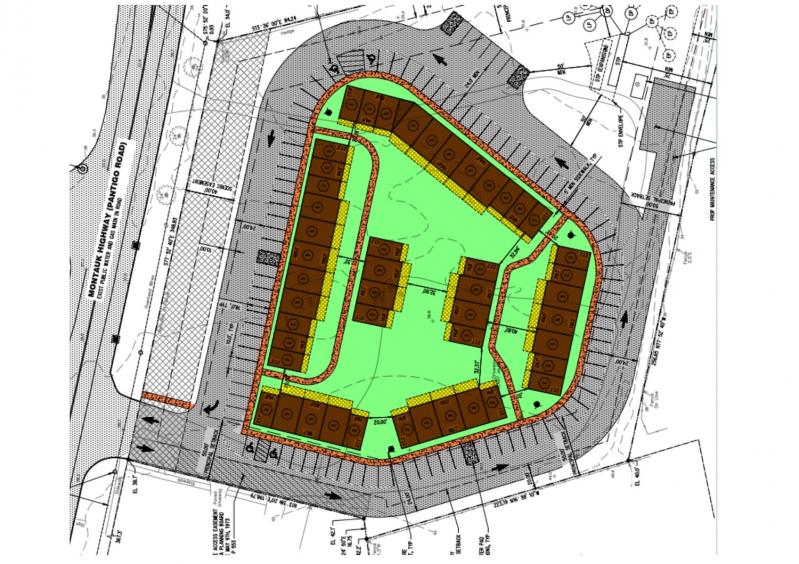It was Dec. 6, 2023, and Randy Parsons, then a member of the East Hampton Town Planning Board, seemed to be at the end of his rope.
“We do not need three more luxury oversized lots,” he said with some exasperation as the board discussed chopping a 3.9-acre site at 350 Pantigo Road in East Hampton into a three-lot subdivision.
He argued that it was the perfect location for affordable housing and since three town board members had just been re-elected promoting the “All Hands on Housing” initiative, he felt they should do whatever necessary to purchase it.
“I feel like the town board should be held accountable for this. No offer has been made,” he said.
Turns out, Mr. Parsons wasn’t the only guy who had had enough that night.
Watching the meeting remotely, Kirby Marcantonio had an idea.
The next day he picked up the phone, reached the owner of the lot, and $5 million later, became a co-owner (his silent partner in the project is the money guy) of 350 Pantigo, former home of the Stern’s Department Store.
Fast-forward to June 25 (of this year) and Mr. Marcantonio was in front of the planning board himself for a preliminary site plan review of his 47-unit affordable housing plan.
In the last year, the town code has been changed to allow more density on senior citizen affordable housing developments, 12 units per acre where previously it was eight. For non-senior affordable housing developments, the restriction is still eight units per acre.
However, the planning board can make an exception and allow 12 units per acre if a development includes a sewage treatment plant, finances a traffic study, and analyzes impacts on the school districts.
Christopher Kelley, an attorney for Mr. Marcantonio, said he is working to comply with each of those items.
The plans were well received despite widespread concern among the board about the added density. Members seemed content to move the project along and wait to receive more in-depth analysis with the formal application.
Mr. Marcantonio proposes 24 two-bedroom units and 23 three-bedroom units in seven, two-story, multi-unit buildings arranged inside a large circular parking area. While the layout is atypical, the real innovation is the ownership and management structure.
He plans to sell all the units as condominiums to local businesses for “workforce housing.”
He said Southampton Hospital had already expressed interest in 20. The local business would then rent the unit back to their employees at a maximum affordable rate of 130 percent of the average median income for Suffolk County.
“This incentivizes the private sector to construct affordable housing so not all affordable housing would have to be publicly owned,” said Mr. Kelley.
“This model deviates from nearly every affordable housing development that exists in the town,” said Eric Schantz, a principal planner for the town Planning Department. “Most of those are operated by a certified housing agency or housing corporation like the East Hampton Housing Authority.”
The two main aspects that will need enforcement are the maximum monthly rent, and the maximum family income level.
“Anytime there is a new tenant or on a yearly basis, the owner of that unit has to certify that the tenants still meet the affordability requirements,” he said. “I would recommend that that be a condition of approval.”
He noted that with the current layout, which would have 11 units situated in one parallel row to Montauk Highway, that it would be “very conspicuous.”
Mr. Kelley proposed creating an affordable housing easement, which would condition in perpetuity that only income-qualified tenants could reside in the units. “The condominium board will be empowered to enforce those restrictions. The easement provides the town housing office will certify every tenant certified based on income. This is not to be used as second homes for the owner’s niece or son over the summer.”
“How can you limit the sale of these to a specific segment of the population?” asked Jennifer Fowkes, a board member.
“I can sell to whoever I want. We’re not discriminating as long as you don’t discriminate against a protected group,” said Mr. Kelley.
“What happens if a business owns units and decides to leave town?” asked Reed Jones, another board member.
“They can sell to whomever they want, with the proviso that the only people that can occupy the units are income-qualified people. That’s the anchor of this whole project,” said Mr. Kelley. If an employee who lived in a unit got fired, he continued, they’d have at least 90 days before they had to move out.
“The other side of that coin is that the tenant is basically a serf of the business,” said Louis Cortese, a planning board member. He offered a further criticism, noting the scarcity of land available to the town for affordable housing projects.
“I think what’s happening here, and I know you bought the property fair and square, is we’re taking away from affordable housing for moderate income year-round residents and putting it in play for a different type of resident. Someone that’s more transient. Someone that’s not really part of the community. They may be here for a year or two. It’s a different demographic that’s going into these units.”
“We’re not trying to co-opt the idea of affordable housing,” said Mr. Marcantonio. “We’re just taking a small sliver of what’s necessary.” He told the board he was already oversubscribed on the project “by probably 100 to 200 percent,” indicating strong demand.
“You do seem like you’re kind of pressing the outer limits on what you can pack in there. You know, almost 100 parking spots and 47 units is quite a bit,” said Mr. Jones. “I’m not necessarily opposed to it, it just seems like a lot.”
“I’m still sort of wrapping my head around the sheer amount of people parking on this lot,” agreed Bruce Siska, a board member. “The traffic study is going to be super important. You have to figure if this is for the workforce, they’ll be a morning mass exodus and in the afternoon everybody’s coming back.”
Should Mr. Marcantonio’s plans not come to fruition, the lot could still be subdivided to accommodate three large houses. The planning board has already sent comments to the town board encouraging the parcel’s use for affordable housing.
“I would rather see this than three more mega houses,” said Ed Krug, the planning board chairman.




